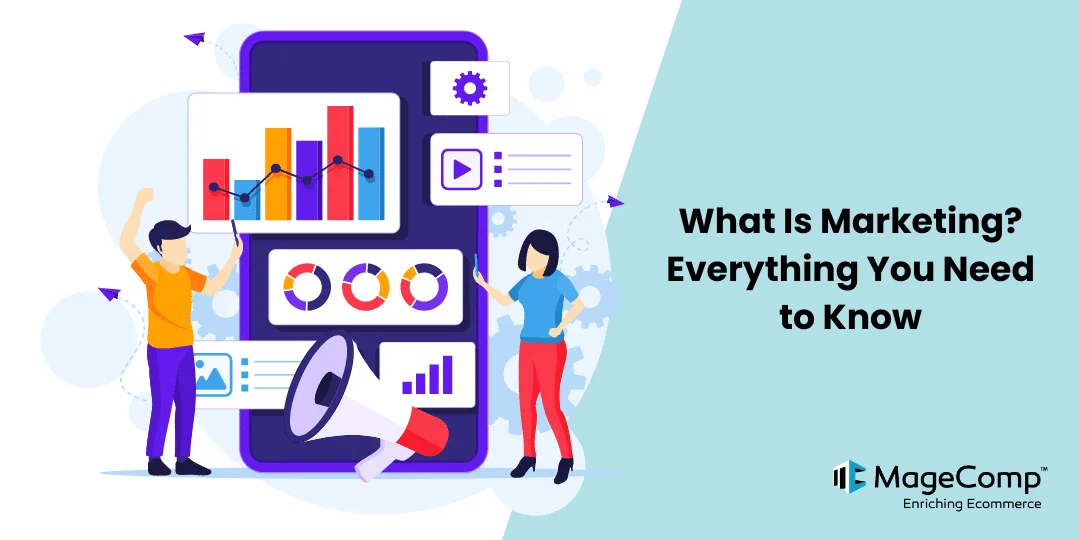In today’s fast-paced and competitive business landscape, marketing plays a pivotal role in the success of any organization. But what exactly is marketing, and why is it so important? Whether you’re a seasoned entrepreneur, a budding startup founder, or simply curious about the world of business, understanding the fundamentals of marketing is essential. In this blog post, we’ll explore what marketing is all about, its types, and why it matters more than ever in today’s digital age.
What is Marketing?
Marketing is the process of promoting, selling, and distributing products or services to targeted consumers. It involves understanding consumer needs and preferences, developing strategies to meet those needs, and communicating the value of products or services to potential customers.
Key components of marketing include market research, product development, pricing, distribution channels, advertising, branding, and customer relationship management. Effective marketing strategies aim to attract, engage, and retain customers while maximizing profitability for businesses.
In today’s digital age, marketing has evolved to encompass a wide range of channels and techniques, including online advertising, social media marketing, content marketing, email marketing, influencer marketing, and search engine optimization (SEO). The goal of marketing is to create awareness, generate interest, drive sales, and build long-term relationships with customers.
4 Ps for Marketing
The 4 P’s of marketing, also known as the marketing mix, are a foundational framework used by marketers to develop and execute marketing strategies. They represent the key elements that businesses can control to influence consumers’ purchasing decisions. The 4 P’s stand for:
Product
This refers to the tangible or intangible offering that a business provides to satisfy consumers’ needs or wants. It includes the features, design, quality, branding, packaging, and any additional services associated with the product.
Price
Price refers to the amount of money customers are willing to pay for the product or service. Pricing strategies involve determining the right price point to maximize profitability while remaining competitive in the market. Factors such as production costs, competitor pricing, perceived value, and pricing strategies (e.g., skimming, penetration, value-based pricing) influence pricing decisions.
Place
Place, also known as distribution, refers to the channels and methods used to make the product or service available to consumers. This includes decisions related to distribution channels (such as direct sales, retailers, wholesalers, or online platforms), logistics, inventory management, and physical locations where the product is sold.
Promotion
Promotion encompasses all the activities used to communicate the value of the product or service to the target audience and persuade them to make a purchase. This includes advertising, sales promotions, public relations, personal selling, direct marketing, and other promotional tactics. The goal of promotion is to raise awareness, stimulate interest, and ultimately drive sales.
Learn more about the 4 Ps of Marketing
Importance of Marketing
Marketing plays a crucial role in the success of businesses and organizations across various industries. Here are some key reasons why marketing is important:
- Customer Identification and Understanding: Marketing helps businesses identify and understand their target customers’ needs, preferences, and behaviors. By conducting market research and analyzing consumer data, businesses can tailor their products, services, and marketing efforts to better meet customer demands.
- Brand Awareness and Recognition: Effective marketing increases brand awareness and recognition among target audiences. Through consistent messaging, branding elements, and promotional activities, businesses can establish a strong brand presence in the market, making it easier for customers to recognize and choose their products or services over competitors.
- Customer Acquisition and Retention: Marketing helps businesses attract new customers and retain existing ones. By implementing various marketing strategies such as advertising, promotions, and customer relationship management, businesses can generate leads, convert prospects into customers, and foster long-term relationships with loyal customers.
- Market Differentiation and Competitive Advantage: Marketing enables businesses to differentiate themselves from competitors and highlight their unique value propositions. By effectively communicating their strengths, benefits, and distinctive features, businesses can stand out in the market and gain a competitive advantage.
- Revenue Generation and Profitability: Marketing plays a direct role in driving sales and revenue growth for businesses. By promoting products or services, creating demand, and persuading customers to make purchases, marketing efforts contribute to the overall profitability and financial success of organizations.
- Product Development and Innovation: Marketing insights and feedback from customers can inform product development and innovation initiatives. By understanding customer needs and preferences, businesses can identify opportunities for new products or improvements to existing ones, driving innovation and staying ahead of market trends.
- Market Expansion and Global Reach: Marketing enables businesses to expand into new markets and reach customers beyond their local or regional boundaries. Through international marketing efforts, businesses can penetrate new markets, establish partnerships, and leverage global opportunities for growth and expansion.
- Relationship Building and Brand Loyalty: Effective marketing fosters strong relationships with customers and builds brand loyalty over time. By engaging with customers, providing excellent customer service, and delivering value-added experiences, businesses can create loyal advocates who continue to support and recommend their brand to others.
Types of Marketing
There are various types of marketing strategies and approaches that businesses can use to reach their target audience and achieve their marketing goals. Some common types of marketing include:
Digital Marketing
This encompasses all marketing efforts that use electronic devices or the internet. It includes channels such as websites, search engines, social media, email, mobile apps, and online advertising.
Check out some Digital Marketing Tools that help you grow
Content Marketing
Content marketing focuses on creating and distributing valuable, relevant, and consistent content to attract and retain a clearly defined audience. It aims to provide information, solve problems, or entertain consumers, rather than directly promoting a brand or product.
Find out Content Marketing Strategies for your business
Social Media Marketing
This involves using social media platforms such as Facebook, Instagram, Twitter, LinkedIn, and TikTok to promote products or services, engage with customers, and build brand awareness. Social Media Marketing tools can help to manage social media presence more effectively.
Find out – How to Boost Sales with Social Media Marketing
Influencer Marketing
Influencer marketing involves collaborating with individuals who have a large and engaged following on social media or other online platforms to promote products or services to their audience.
Email Marketing
Email marketing involves sending commercial messages to a group of people via email. It can be used for purposes such as promoting products, providing updates, nurturing leads, and building relationships with customers.
Learn – How to Integrate Email Marketing with Shopify
Relevant Read- Everything you Need to Know about Email Marketing
Search Engine Optimization (SEO)
SEO focuses on optimizing a website’s content, structure, and backlinks to improve its visibility and ranking in search engine results pages (SERPs). It aims to increase organic (non-paid) traffic to the website.
Search Engine Marketing (SEM)
SEM involves using paid advertising to appear in search engine results pages. It typically includes pay-per-click (PPC) advertising, where advertisers bid on keywords to display ads to users searching for related terms.
Affiliate Marketing
Affiliate marketing is a performance-based marketing strategy where businesses reward affiliates (publishers or influencers) for promoting their products or services and driving sales or leads through their referral links.
Check – Definitive Guide for Affiliate Marketing
Guerrilla Marketing
Guerrilla marketing involves using unconventional and creative tactics to promote a product or service in a memorable and impactful way, often with limited resources.
Traditional Marketing
Traditional marketing methods include print advertisements, television commercials, radio ads, direct mail, billboards, and events. While digital marketing has become increasingly popular, traditional marketing still has its place in certain industries and target markets.
Best Practices for Marketing
Effective marketing involves a combination of strategies, techniques, and best practices to reach and engage with target audiences and achieve business objectives. Here are some key best practices for marketing:
- Define Clear Goals and Objectives: Before implementing any marketing strategy, define clear and measurable goals that align with your overall business objectives. Whether it’s increasing brand awareness, generating leads, driving sales, or improving customer retention, having specific goals will help guide your marketing efforts and measure success.
- Know Your Audience: Understand your target audience’s demographics, interests, behaviors, and pain points. Conduct market research, analyze customer data, and create detailed buyer personas to tailor your messaging and content to resonate with your audience effectively.
- Provide Value: Focus on providing value to your audience through your marketing efforts. Whether it’s educational content, helpful resources, entertaining videos, or exclusive offers, aim to solve problems, answer questions, or fulfill needs to build trust and credibility with your audience.
- Consistent Branding: Maintain consistent branding across all marketing channels and touchpoints to create a cohesive and recognizable brand identity. Use consistent brand colors, fonts, messaging, and imagery to reinforce your brand’s personality and values.
- Multi-Channel Approach: Take advantage of multiple marketing channels to reach your audience wherever they are. Utilize a mix of digital channels (such as social media, email, website, and search engines) and traditional channels (such as print, TV, radio, and events) to maximize your reach and visibility.
- Content Marketing: Develop a content marketing strategy to create valuable, relevant, and engaging content for your audience. This can include blog posts, articles, videos, infographics, podcasts, webinars, and more. Focus on quality over quantity and tailor your content to address the needs and interests of your target audience.
- Optimize for SEO: Implement search engine optimization (SEO) best practices to improve your website’s visibility and ranking in search engine results pages (SERPs). Optimize your website structure, content, keywords, meta tags, and backlinks to attract organic traffic and improve your search engine rankings.
- Engage on Social Media: Leverage social media platforms to engage with your audience, build relationships, and promote your brand. Create compelling content, interact with followers, respond to comments and messages, and participate in relevant conversations to foster a sense of community and loyalty.
- Monitor and Analyze Performance: Regularly monitor the performance of your marketing campaigns and initiatives using key performance indicators (KPIs) and analytics tools. Track metrics such as website traffic, engagement, conversions, ROI, and customer feedback to measure success and identify areas for improvement.
- Stay Agile and Adapt: The marketing landscape is constantly evolving, so be prepared to adapt and adjust your strategies based on changing trends, consumer behavior, and industry developments. Stay agile, experiment with new approaches, and learn from both successes and failures to continually refine and optimize your marketing efforts.
What Happens to Business without Marketing?
Running a business without marketing is akin to driving a car without headlights – it’s possible, but you’re likely to encounter numerous obstacles and challenges along the way. While some businesses may initially gain traction through word-of-mouth referrals or other forms of organic growth, the absence of marketing can severely limit their long-term success and scalability. Here are some potential consequences of operating a business without marketing:
- Limited Visibility: Without marketing efforts to promote your products or services, your business may remain largely invisible to potential customers. This can result in slower growth, as you struggle to attract new customers and expand your customer base.
- Reduced Competitive Advantage: In today’s competitive marketplace, businesses need to differentiate themselves from competitors to stand out and attract customers. Effective marketing allows you to highlight your unique value proposition and persuade customers to choose your offerings over alternatives.
- Difficulty Reaching Target Audience: Marketing enables businesses to identify and target specific customer segments with tailored messages and offers. Without targeted marketing efforts, you may struggle to reach and engage with your ideal customers, leading to inefficient use of resources and missed opportunities.
- Lower Sales and Revenue: Marketing plays a crucial role in driving sales and revenue growth by creating awareness, generating leads, and influencing purchase decisions. Without marketing initiatives to stimulate demand and drive customer acquisition, your business may experience stagnation or declining sales over time.
- Limited Brand Building: Marketing is instrumental in building brand awareness, recognition, and loyalty among consumers. A strong brand presence helps businesses establish credibility, trust, and loyalty with customers, leading to repeat purchases and referrals. Without marketing efforts to cultivate your brand, you may struggle to build meaningful relationships with customers and maintain a competitive edge in the market.
- Ineffective Communication: Marketing facilitates effective communication between businesses and customers, enabling you to convey important messages, promotions, and updates. Without marketing channels to reach and engage with your audience, you may miss opportunities to communicate key information and address customer needs and concerns.
- Difficulty Scaling the Business: As your business grows, marketing becomes increasingly important for scaling operations and reaching new markets. Without marketing strategies to support expansion efforts, you may encounter challenges in reaching new customers, entering new markets, and achieving sustainable growth.
Final Thoughts
In conclusion, marketing is a multifaceted discipline that encompasses various activities aimed at understanding, attracting, and retaining customers. From market research and product development to pricing strategies and promotional efforts, marketing is essential for businesses to thrive in today’s competitive marketplace.
By embracing the principles of marketing and staying abreast of industry trends and innovations, businesses can effectively reach their target audiences, drive growth, and achieve long-term success. So, whether you’re a small startup or a multinational corporation, investing in marketing is key to unlocking your full potential in the business world.





